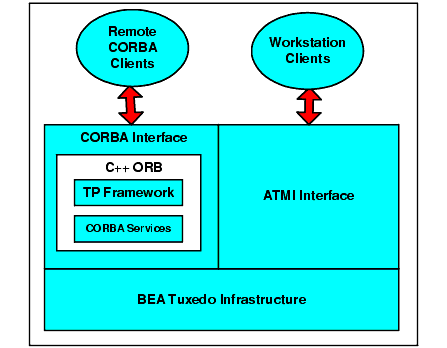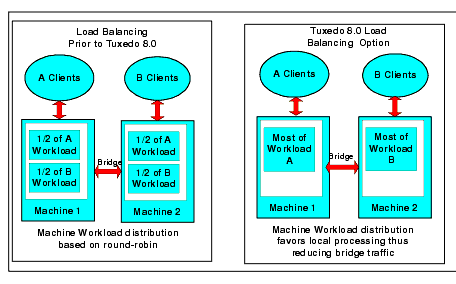
![BEA BEA Tuxedo Release [Release Number]](../images/top.gif)

|
![BEA BEA Tuxedo Release [Release Number]](../images/top.gif)
|
|
|
|
Introduction
This topic includes the following sections:
Overview
In a modern, transaction-driven, global economy, your competitive resources are not only the people you hire and the products you produce, but also the software and systems that interconnect the enterprise. Mission-critical software can help you gain the competitive edge in the ever-expanding arena of globally connected electronic commerce. Transaction Monitors (TMs) is the technology upon which this competitive advantage is being built. The BEA Tuxedo system provides the best-of-breed TM for the development and deployment of your mission-critical applications.
Additionally, the BEA Tuxedo software provides businesses and organizations that depend on mission-critical applications with the flexibility of two proven programming interfaces: a Common Object Request Broker Architecture (CORBA) interface and an Application-to-Transaction Monitor Interface (ATMI). As illustrated in Figure 1-1, both interfaces use the BEA Tuxedo infrastructure, which has demonstrated, through years of use in large, transaction-based, production systems, that it is powerful, robust, scalable, manageable, and reliable.
Figure 1-1 BEA Tuxedo Product
CORBA Interface The CORBA interface provides a C++ server ORB, the TP Framework, and several CORBA services, including FactoryFinder, Naming Service, Notification Service, the Interface Repository, and the Transaction Service. C++, Java, and ActiveX client ORBs are also included with the BEA Tuxedo software to support the development of remote client applications. For more information on the BEA Tuxedo CORBA interface, see Getting Started with BEA Tuxedo CORBA Applications in the online documentation. ATMI Interface ATMI provides an interface for communications, transactions, and management data buffers that works in all environments supported by the BEA Tuxedo ATMI interface. ATMI defines the interface between application programs and the BEA Tuxedo system. It offers a simple interface for a comprehensive set of capabilities. It implements the X/Open distributed transaction processing (DTP) model for transaction processing. For more information on the BEA Tuxedo ATMI interface, see Introducing BEA Tuxedo ATMI in the online documentation.
Packaging
The following changes have been made to the product packaging:
New Features and Enhancements in this Release
Release 8.0 of BEA Tuxedo includes the following new features and enhancements:
Support for Multithreaded CORBA C++ Applications
Release 8.0 of BEA Tuxedo supports multithreaded C++ client and server applications. While there are many advantages to writing multithreaded applications, there are some disadvantages such as application complexity. BEA Tuxedo 8.0 supports two threading models: thread per object and thread per request.
The characteristics of each model are as follows:
For more information on writing multithreaded applications, see Creating CORBA Server Applications in the online documentation.
Support for CORBA C++ Unicode Character Set
Release 8.0 of the BEA Tuxedo software supports international (multi-byte) characters, or wide characters. Support for wide characters enables the Unicode character set to be used in the CORBA Interface Definition Language (IDL) and in CORBA client and server applications. As part of this new functionality, the C++ IDL compiler now supports wchar and wstring data types, recursive sequences, indirect typecodes, and forward references.
For more information on support for wide characters, see the CORBA Programming Reference in the online documentation.
Load Balancing Optimizations
Release 8.0 of BEA Tuxedo includes new load balancing features. In BEA WebLogic Enterprise 5.1, in a multiprocessor configuration, load balancing randomly distributed the workload across all machines supporting a particular interface within a domain. In BEA Tuxedo 8.0, load balancing favors the local machine when distributing workload and, thus, reduces bridge traffic (see Figure 1-2).
Additionally, support for parallel objects was added to BEA Tuxedo CORBA in release 8.0 as a performance enhancement. The parallel objects feature enables you to designate all business objects in a particular application as stateless objects. The effect is that, unlike stateful business objects which can only run on one server in a single domain, stateless business objects can run on all servers in a single domain. Thus, the benefits of parallel objects are as follows:
For more information on parallel objects, see Scaling, Distributing, and Tuning CORBA Applications in the online documentation.
Figure 1-2 Load Balancing Optimizations
Support for C++ Object-by-Value Types Support for C++ object-by-value types enhances the ability of BEA Tuxedo CORBA C++ applications to access BEA WebLogic Servers 6.0 via RMI/IIOP. For more information on object-by-value types, see Interoperability Between BEA Tuxedo 8.0 CORBA and BEA WebLogic Server 6.0 Using Object-by-Value Types. Support for Single Sign-On Across ATMI and CORBA Domains Support for the T-Engine security plug-in framework was provided in BEA Tuxedo 7.1 and BEA WebLogic Enterprise 5.1 (CORBA-only), but security context could not be propagated across these environments. In BEA Tuxedo 8.0, both the ATMI and CORBA environments support the same plug-in framework, and therefore, common, interoperable security is achieved. Figure 1-3 Single Sign-On Across Domains
Server Performance Enhancements BEA Tuxedo 8.0 includes the following server options that enable you to customize the server for optimal performance:
Note: The authorization, threading, and transaction options can be turned off individually, however, you should not turn off any of these features if your applications require them.
For information on how to use the above performance options, see "Tuning a BEA Tuxedo Application" in Administering a BEA Tuxedo Application at Run Time in the online documentation.
Domain Enhancements
Enhancements have been made to the BEA Tuxedo Domains software to improve performance in the following areas:
Enhancements to Jolt to Improve Interoperability Between BEA WebLogic Server BEA Tuxedo ATMI
In release 8.0, the Jolt software includes the following enhancements that improve the integration of BEA WebLogic Server with BEA Tuxedo services (see Figure 1-4):
Figure 1-4 BEA WebLogic Server Integration Enhancements
Product Upgrades
Figure 1-5 shows the existing BEA Tuxedo and BEA WebLogic Enterprise products that can be upgraded to BEA Tuxedo 8.0.
Figure 1-5 Upgrade Paths

|

|
|
|
|
Copyright © 2001 BEA Systems, Inc. All rights reserved.
|